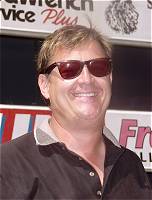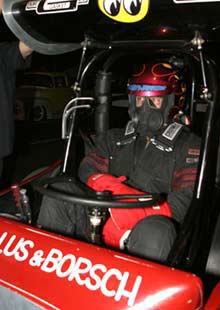
Why Safety?
10/8/04
 
ccording to the dictionary: Safe-tee (n) "condition of being safe; freedom
from danger or injury."
While at the 50th U.S. Nationals doing the legwork for our "Time to Re-Tire" article on the problems with current drag racing tire technology, I became even more aware of that word safety. I can remember when there wasn't a decal or a piece of paper that went out of NHRA that did not include "Dedicated to Safety" prominently onboard. After talking with a number of racers I found once again that safety is always a big part of everyday drag racing life, entrenched in the careful way their belts are tightened, window net in place, neck collar positioned, helmet adjusted and driving gloves worn.
All this seems to come back to the forefront when a sadly bizarre occurrence such as Darrell Russell's death happens. With new slicks mandated for change by NHRA, there seemed to be a complacency that all had been fixed and made better, but it had not.
I appreciated the candid conversations I had with Charlotte and Forrest Lucas. They were now confronted with safety as it related to their son Morgan, in a way they never could have imagined as Wayne Dupuy declined to make a final qualifying pass because of tire chunking.
Hopefully the new/old D1430 slicks will keep up with the new higher volume fuel pumps designed to skirt the 85 percent rules, more volume - more nitro volume - even if it's at 85 percent. Since a genius like Austin Coil has obviously figured out how to grab the limelight back with his 4.665 333.58 mph charge at Chicago … if the rule changes were truly to slow down the nitro cars for safety, why has there been no fuel pump spec for the big cars? Did NHRA's tech department really think no crew chiefs would figure this out?
Who needs the HANS Device?
For me, one of the true highlights of the recent 50th U.S. Nationals was the crowd reaction to fuel altereds showing their stuff by making exhibition runs at night. If you attend a Goodguys VRA event during the year you'll probably see Mike Boyd piloting the Winged Express. I had the fortune to see Wild Willie Borsch drive the original Winged Express, but Boyd has the balls with the perspective of safety that is so necessary today.
 The
Winged Express and Randy Bradford's Fiat made
side-by-side passes on Friday night and as Bob
Frey says, "The crowd went wild!" On Saturday
morning I was talking with Fred Simmonds of
GM Racing who was explaining their program to
spread the virtues of the HANS Device into drag
racing by distributing a VHS video and providing
the safety apparatus to GM drivers at a reduced
price. If you pick up one of these free videos
you'll see how the human neck extends in only
a 35 mph crash. Then, in walked Tom Gideon,
head of the GM HANS program who said, "Did you
see that fuel altered show last night? That
guy is crazy running a car like that (Winged
Express) without wearing a HANS Device!" The
Winged Express and Randy Bradford's Fiat made
side-by-side passes on Friday night and as Bob
Frey says, "The crowd went wild!" On Saturday
morning I was talking with Fred Simmonds of
GM Racing who was explaining their program to
spread the virtues of the HANS Device into drag
racing by distributing a VHS video and providing
the safety apparatus to GM drivers at a reduced
price. If you pick up one of these free videos
you'll see how the human neck extends in only
a 35 mph crash. Then, in walked Tom Gideon,
head of the GM HANS program who said, "Did you
see that fuel altered show last night? That
guy is crazy running a car like that (Winged
Express) without wearing a HANS Device!"
Knowing that the Marcellus-Borsch & Boyd fuel altered was a low-buck operation I suggested GM Racing give a HANS Device to driver Boyd as an example to vintage nostalgia drag racers. Tom and Fred thought that was a good idea and the wheels were set in motion. I then headed over into the sportsman pits to talk with Boyd. If you've not seen Mike, he's a tall, imposing, body builder-type dude who looks like he could kick just about anyone's ass, but when we spoke about GM's generous offer his eyes began to well up with tears that someone cared enough about his safety.
Fast-forward to the California Hot Rod Reunion
XIII; Boyd has his HANS Device installed. He's
comfortable wearing it and now he's spreading
the word to other drivers who pilot vintage
tin thanks to the modern safety thinking of
GM Racing.

|